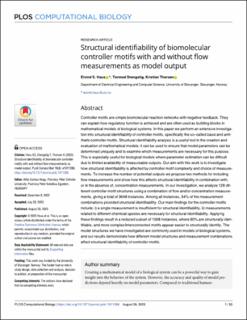| dc.contributor.author | Haus, Eivind Sandve | |
| dc.contributor.author | Drengstig, Tormod | |
| dc.contributor.author | Thorsen, Kristian | |
| dc.date.accessioned | 2023-10-12T08:34:38Z | |
| dc.date.available | 2023-10-12T08:34:38Z | |
| dc.date.created | 2023-09-12T08:41:24Z | |
| dc.date.issued | 2023-08 | |
| dc.identifier.citation | Haus, E.S., Drengstig, T. & Thorsen, K. (2023) Structural identifiability of biomolecular controller motifs with and without flow measurements as model output, 19(8): e1011398. | en_US |
| dc.identifier.issn | 1553-734X | |
| dc.identifier.uri | https://hdl.handle.net/11250/3095990 | |
| dc.description.abstract | Controller motifs are simple biomolecular reaction networks with negative feedback. They can explain how regulatory function is achieved and are often used as building blocks in mathematical models of biological systems. In this paper we perform an extensive investigation into structural identifiability of controller motifs, specifically the so–called basic and antithetic controller motifs. Structural identifiability analysis is a useful tool in the creation and evaluation of mathematical models: it can be used to ensure that model parameters can be determined uniquely and to examine which measurements are necessary for this purpose. This is especially useful for biological models where parameter estimation can be difficult due to limited availability of measureable outputs. Our aim with this work is to investigate how structural identifiability is affected by controller motif complexity and choice of measurements. To increase the number of potential outputs we propose two methods for including flow measurements and show how this affects structural identifiability in combination with, or in the absence of, concentration measurements. In our investigation, we analyze 128 different controller motif structures using a combination of flow and/or concentration measurements, giving a total of 3648 instances. Among all instances, 34% of the measurement combinations provided structural identifiability. Our main findings for the controller motifs include: i) a single measurement is insufficient for structural identifiability, ii) measurements related to different chemical species are necessary for structural identifiability. Applying these findings result in a reduced subset of 1568 instances, where 80% are structurally identifiable, and more complex/interconnected motifs appear easier to structurally identify. The model structures we have investigated are commonly used in models of biological systems, and our results demonstrate how different model structures and measurement combinations affect structural identifiability of controller motifs. | en_US |
| dc.language.iso | eng | en_US |
| dc.publisher | Public Library of Science (PLoS) | en_US |
| dc.rights | Navngivelse 4.0 Internasjonal | * |
| dc.rights.uri | http://creativecommons.org/licenses/by/4.0/deed.no | * |
| dc.subject | controller motifs | en_US |
| dc.title | Structural identifiability of biomolecular controller motifs with and without flow measurements as model output | en_US |
| dc.type | Peer reviewed | en_US |
| dc.type | Journal article | en_US |
| dc.description.version | publishedVersion | en_US |
| dc.rights.holder | © 2023 Haus et al. | en_US |
| dc.subject.nsi | VDP::Matematikk og Naturvitenskap: 400::Basale biofag: 470 | en_US |
| dc.source.volume | 19 | en_US |
| dc.source.journal | PLoS Computational Biology | en_US |
| dc.source.issue | 8 | en_US |
| dc.identifier.doi | 10.1371/journal.pcbi.1011398 | |
| dc.identifier.cristin | 2174169 | |
| dc.source.articlenumber | e1011398. | en_US |
| cristin.ispublished | true | |
| cristin.fulltext | original | |
| cristin.qualitycode | 2 | |

